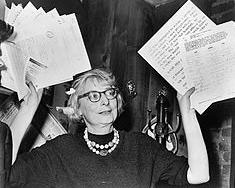Jane Jacobs
Jane Jacobs, (1916-2006) was an American-Canadian writer and activist with primary interest in communities and urban planning and decay. She is best known for ‘The Death and Life of Great American Cities’ (1961), a powerful critique of the urban renewal policies of the 1950s in the United States. The book has been credited with reaching beyond planning issues to influence the spirit of the times. She was instrumental in the cancellation of the Lower Manhattan Expressway (New York) and the Spadina Expressway (Canada). Ms. Jacobs fought to alter the way in which city development was approached. By arguing that cities were living beings and ecosystems, she advocated ideas such as "mixed use" development and bottom-up planning. Her criticisms of high-rise housing projects made her a ‘change agent’ of civic planning practices across the U.S. and abroad. In Melbourne in the 1960s, resident associations fought against large-scale high-rise housing projects of the Housing Commission of Victoria, which they argued had little regard for the impact on local communities. Since Ms. Jacobs was not professionally trained in the field of city planning, she faced criticism from the perennial civic planning establishment, notably the office of Robert Moses, her archrival. Her experience simply came from observation what she called “eyes on the street”. Even with street smart ‘eyes’ Ms. Jacobs could
not predict the eventual outcome of her urban campaigns that promoted preservation of older buildings specifically
because their lack of economic value made them affordable for poor people. She saw the preservation programs
as “guarantors of social diversity". Ms. Jacobs urban planning concepts have been criticized in that her ideas apply only to cities with similar issues to that of New York. In respect to Third World cities, her ideas do not address the problems of scale (when a city grows from one million to ten million) or explaining how infrastructure should be built. One debt owed to Jacobs is that her support of bottom-up and small-scale development initiatives gives evidence that all urban areas are different and require individualized initiatives, as opposed to major projects of urban renewal. In 2001 Ms. Jacobs interviewed with Bill Steigerwald (Reason magazine): Reason: “What do you think you'll be remembered for most? You were the one who stood up to the federal bulldozers and the urban renewal people and said they were destroying the lifeblood of these cities. Is that what it will be?” Jacobs: “No. If I were to be remembered
as a really important thinker of the century, the most important thing I've contributed is my discussion of what
makes economic expansion happen. This is something that has puzzled people always. I think I've figured out what it
is. Reason: “It's not a zero-sum game. It's a bigger, growing pie.” Jacobs: “That's the actual mechanism of it. The theory of it is what I explain in The Nature of Economies. I equate it to what happens with biomass, the sum total of all flora and fauna in an area. The energy, the material that's involved in this, doesn't just escape the community as an export. It continues being used in a community, just as in a rainforest the waste from certain organisms and various plants and animals gets used by other ones in the place.”
|
